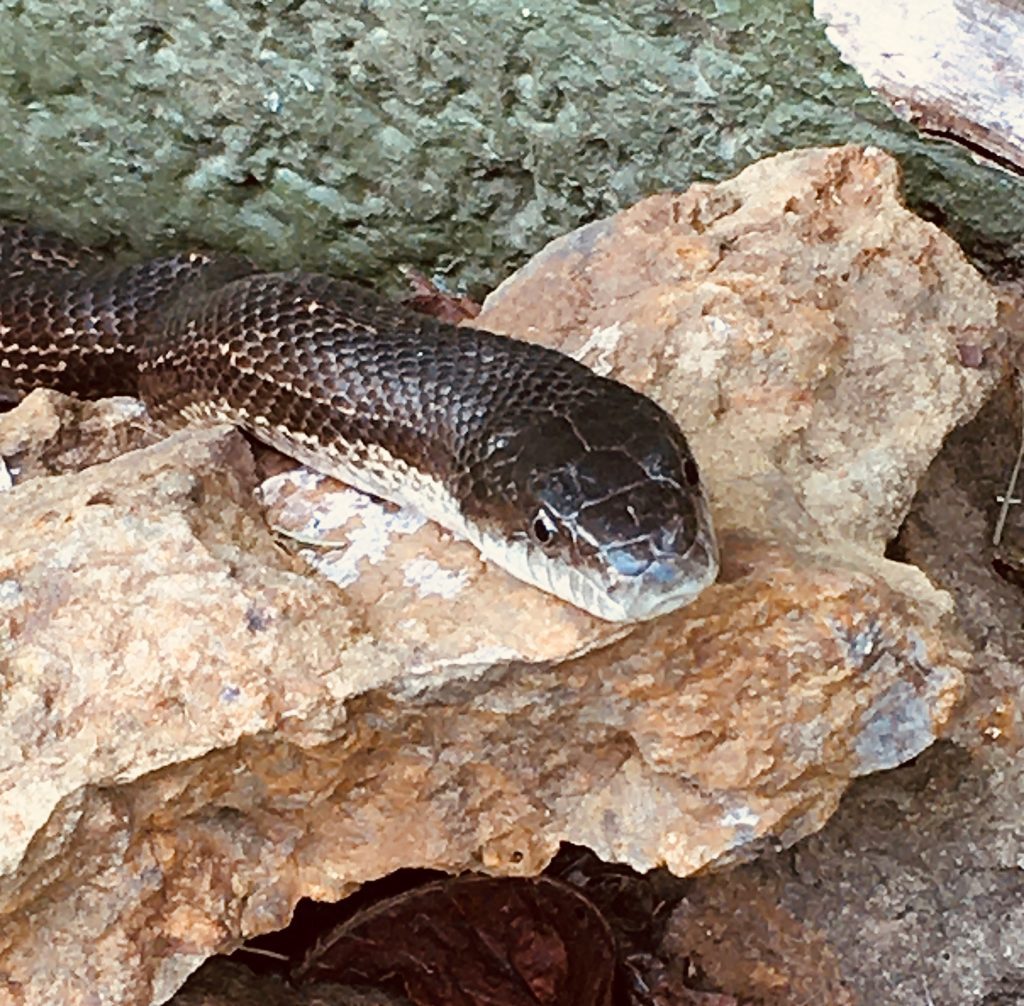by Patrick McShea
Last April, when reports of a large unidentified snake in Frick Park briefly captured the attention of Pittsburgh news media, Park Ranger Erica Heide was not alarmed. As she explained nearly a year later, “I knew it had to be a black rat snake, and I knew who to check with.” One of the city park’s longtime maintenance staff had earlier told Erica about a large snake he had encountered enough times to merit the bestowing of a name. “That’s Charlie,” he reassured her, “I get reports about him every spring.”
Early rumors, which included speculation that someone had released a large python into the park, were dispelled within hours by a widely shared photograph depicting what was clearly a black rat snake fully exposed in a still leafless trailside sapling. Erica, who has worked in her position for the City of Pittsburgh since 2017, now focuses on the benefits of the publicity. “Overall, the event had positive impact. For some weeks afterward I’d be stopped along the trails by park visitors asking how they could be sure to avoid an encounter with the snake, and by just as many others who wanted to know where they could go to see it. For both groups, and for everyone else whose interest level fell somewhere between those positions, the knowledge that this city park can support and sustain a wide variety of wildlife has certainly been a good thing.”

At Carnegie Museum of Natural History, it’s well understood that whenever snakes are the topic of a public presentation, a similar audience stratification comes into play. During such circumstances fearful and fascinated people occupy widely separated edge positions. Within the Section of Amphibians and Reptiles, Assistant Curator Jen Sheridan and Collection Manager Stevie Kennedy-Gold frequently use their positions to diminish the fear of snakes by increasing background knowledge about the creatures’ life cycles, physical adaptations, behaviors, and ecosystem roles. Stevie has recently created a full alphabet-referenced set of 26 TikTok videos that introduce viewers to preserved amphibian and reptile specimens, including many snakes, in the museum’s scientific collection. In early February Jen and Stevie welcomed NEXTPittsburgh’s Boaz Frankel on a tour of their section’s alcohol-preserved specimens for an episode of the weekly YouTube series, Yinzer Backstage Pass.
One highlight of the 30-minute program features Jen holding a large glass jar containing the preserved remains of a type of snake she has frequently encountered during fieldwork in Borneo, the venomous species known to science as Tropidolaemus subannulatus. “What’s really cool about these guys in the field is that they often will sit in the same place for days, and you can go back and take pictures of them, and I can bring students to look at them and admire their beautiful green color.”
Jen’s excitement in relating first-hand experiences as a scientist visiting an exotic environment will undoubtedly move some viewers closer to acceptance of snakes as valued biodiversity markers in a distant land. For a broader acceptance of black rat snakes as neighborhood wildlife, however, the advice Robin Wall Kimmerer, a botanist who is a member of the Citizen Potawatomi Nation, offered to museum staff earlier this month might be even more important. “Native names are important,” the author of Braiding Sweetgrass, reminded us during an informal talk that was part of her appearance as a Pittsburgh Arts and Lectures’ Ten Evenings speaker. “Their use says, ‘We’re not the first ones here.’”
The comments prompted me to retrieve a year-old email message from Deborah Harding, the recently retired Collection Manager for the museum’s Section of Anthropology, and someone who has developed close personal and professional relations with Cherokee artists through her knowledge of traditional weaving practices. As media panic subsided when the snake in the Frick Park tree had been identified, Deb sent a one-line message that explained the creature’s predictable behavior:
The Cherokee word for blacksnake is “ulisdi” = “the one who climbs”.
Patrick McShea is an Educator at Carnegie Museum of Natural History. Museum employees blog about their unique experiences and knowledge gained from working at the museum.
Related Content
Do Snakes Believe in the Tooth Fairy?
Collected On This Day in 1906: Flowering Dogwood in Frick Park
Carnegie Museum of Natural History Blog Citation Information
Blog author: McShea, PatrickPublication date: April 28, 2022
